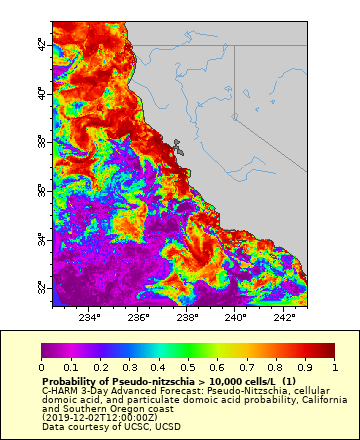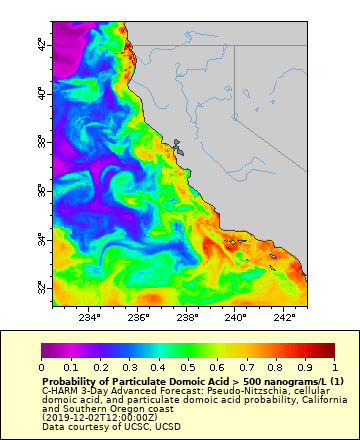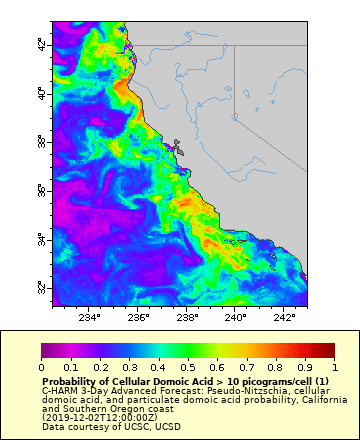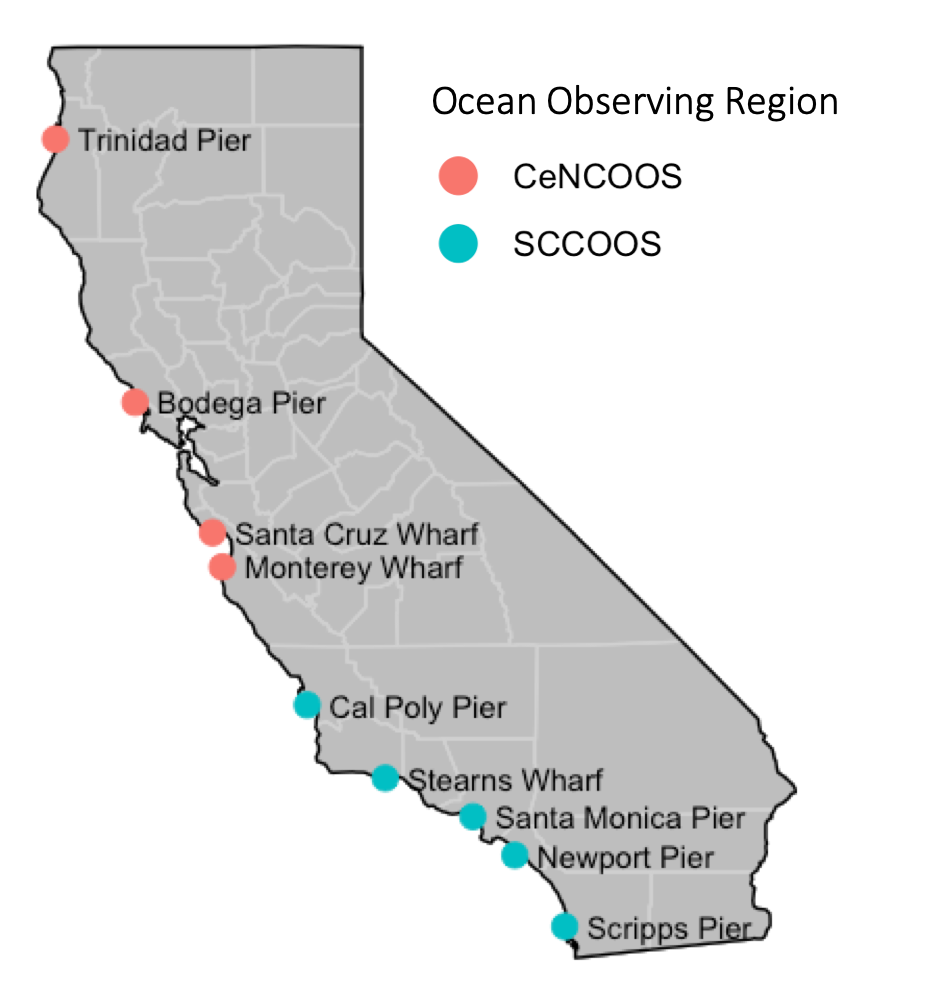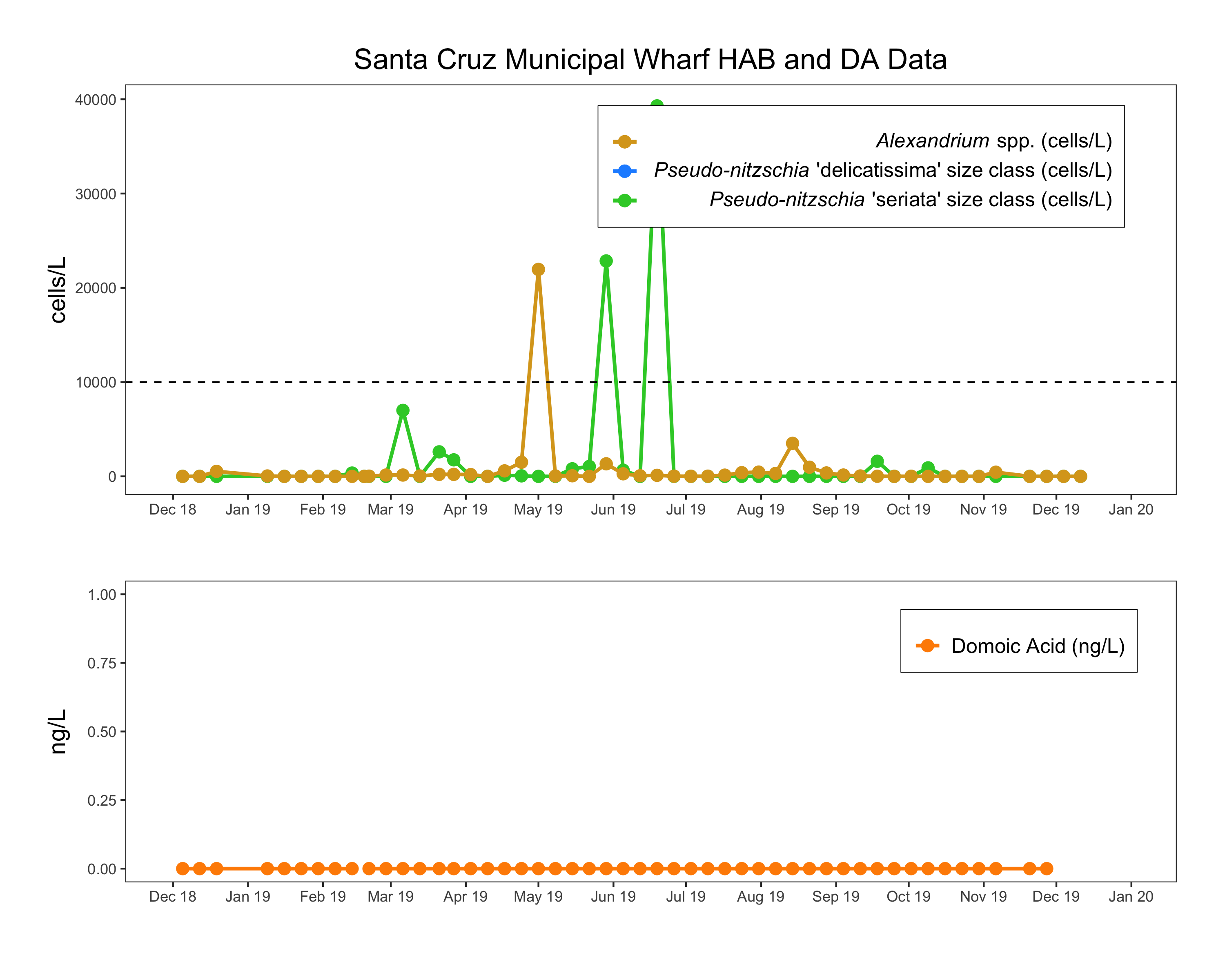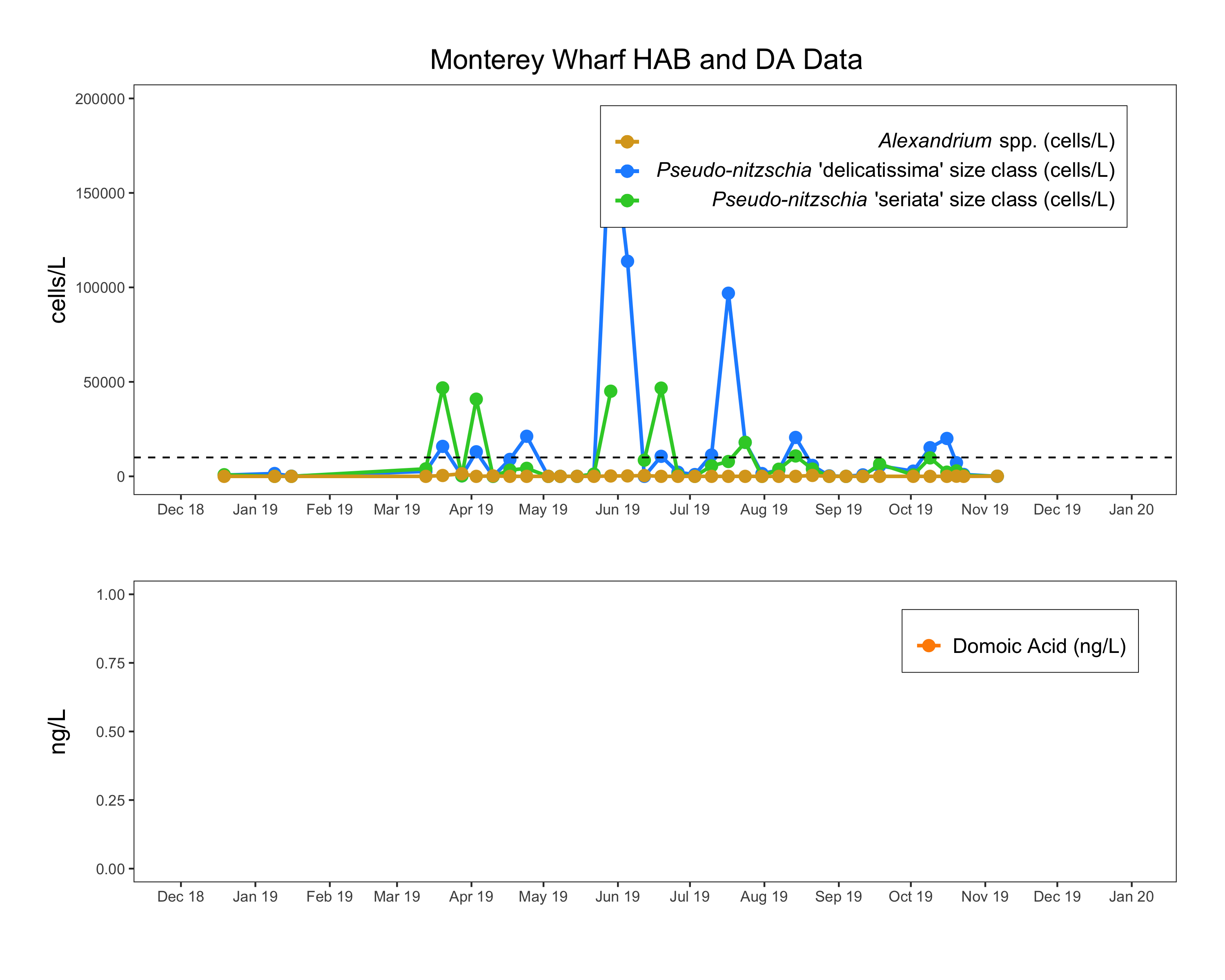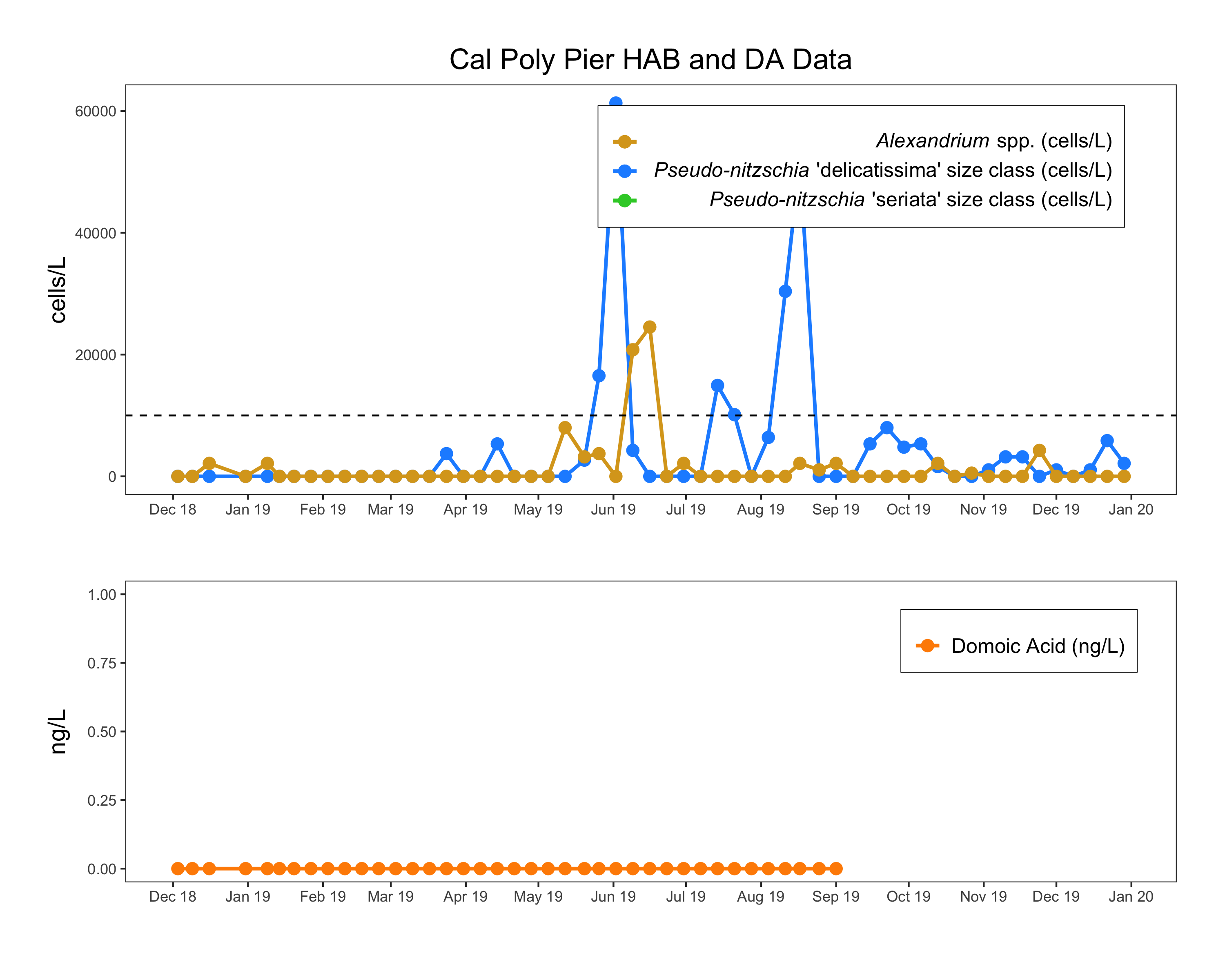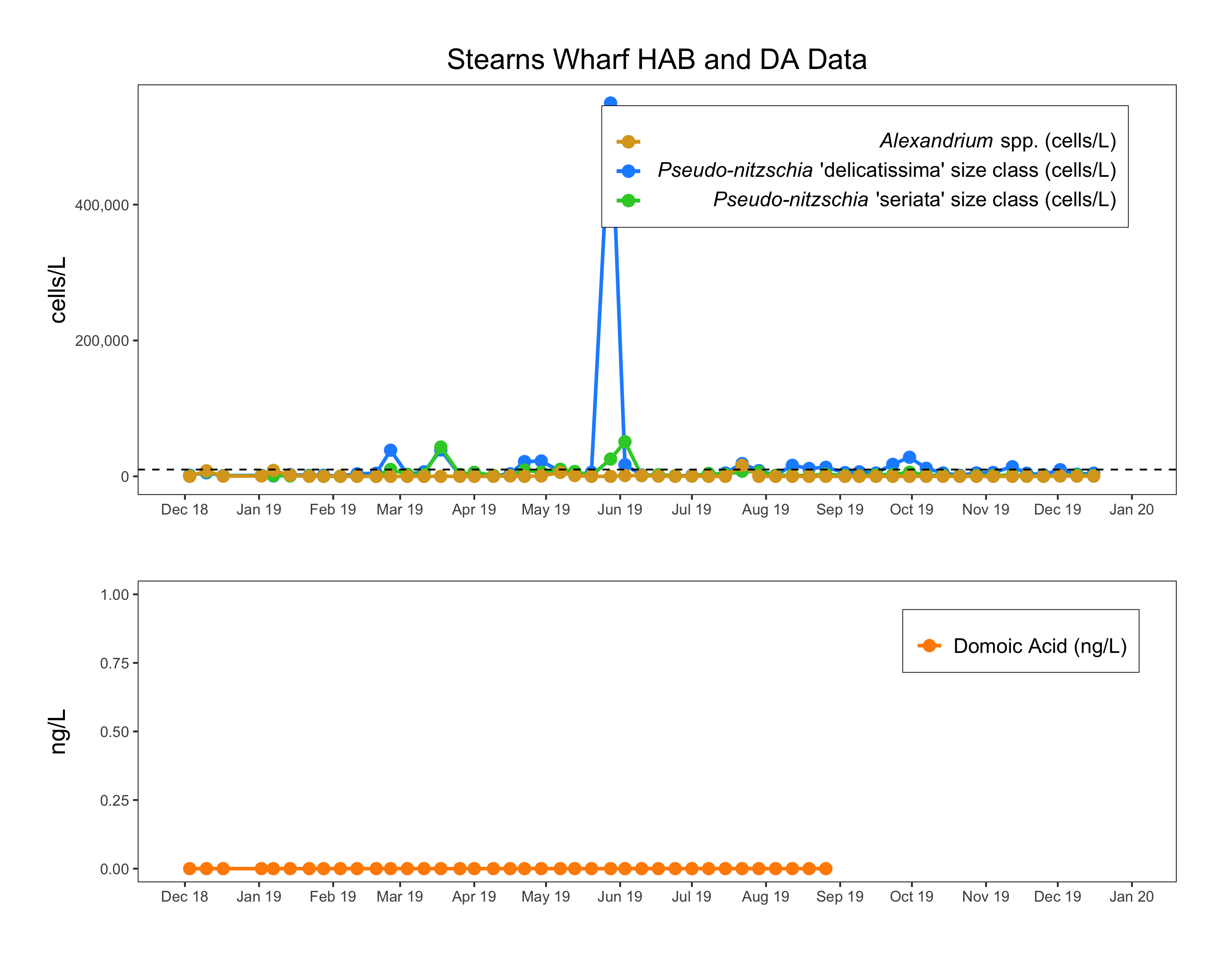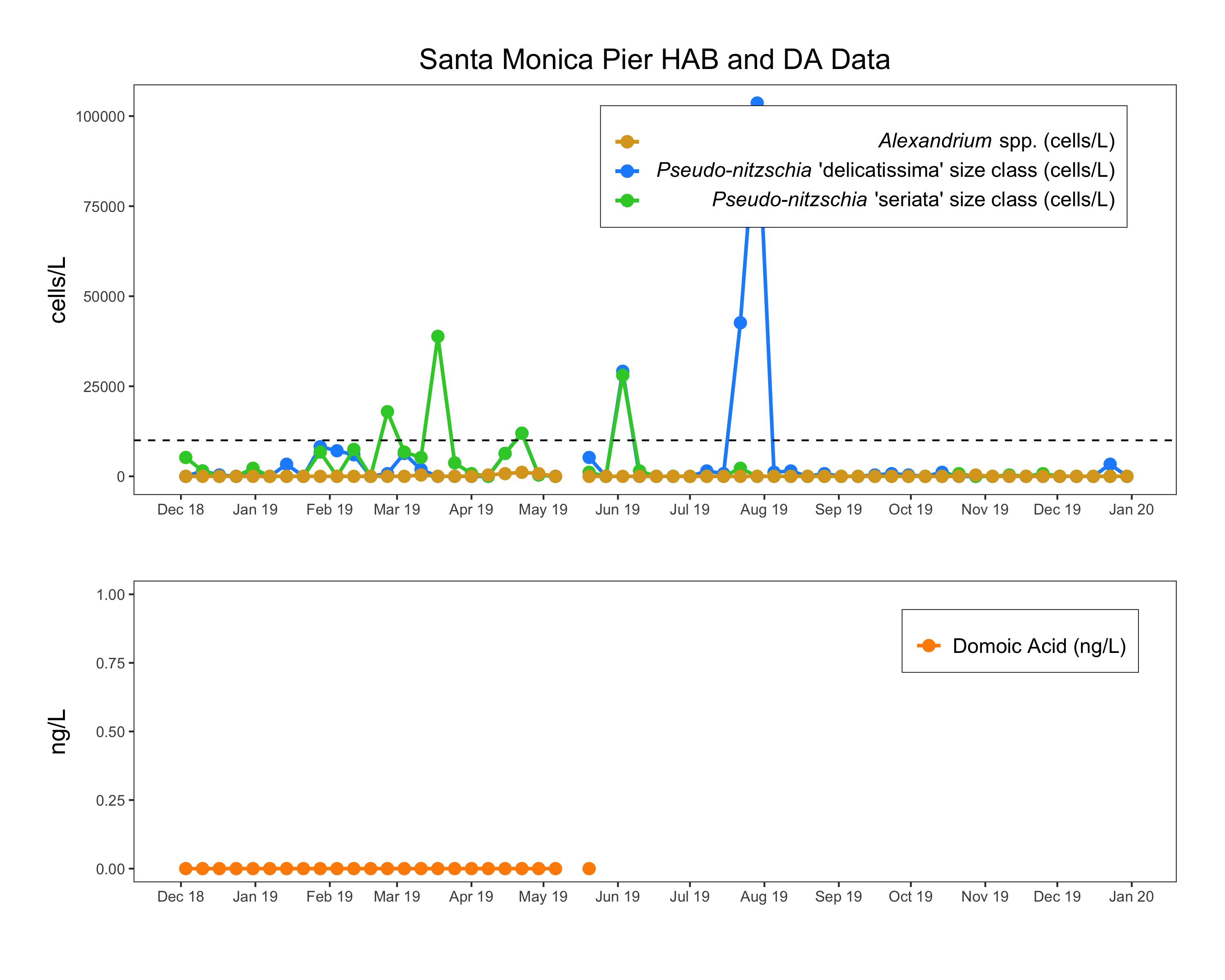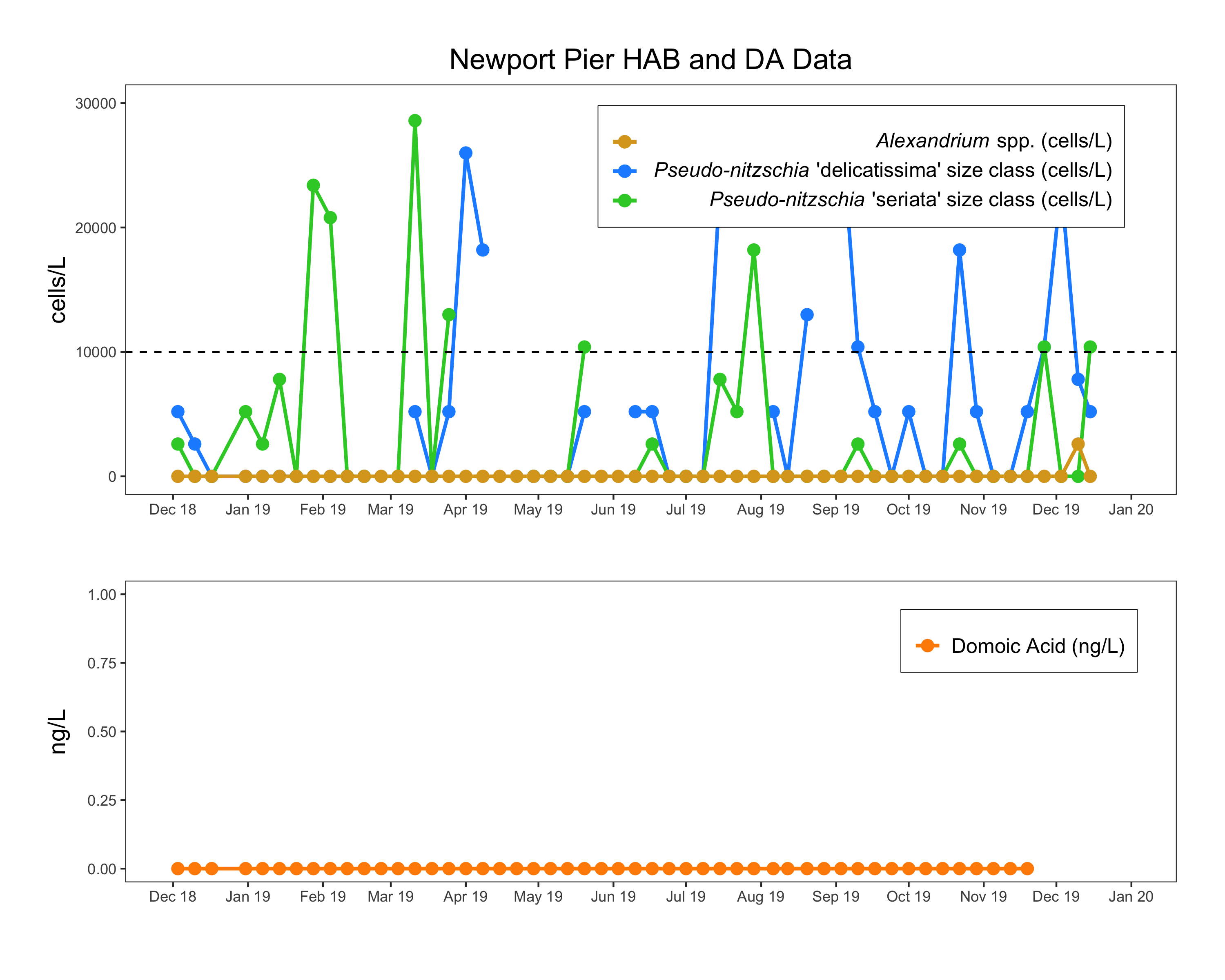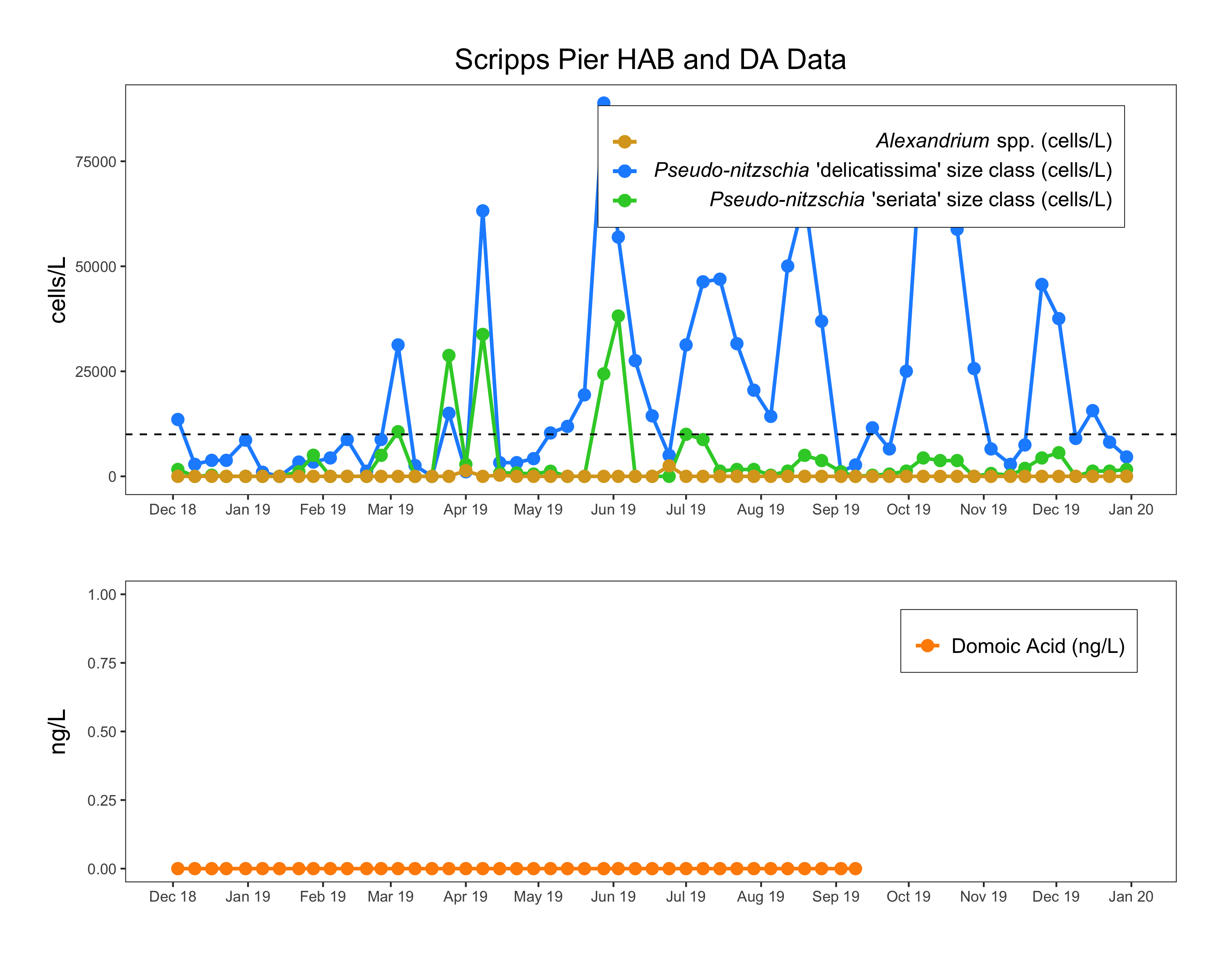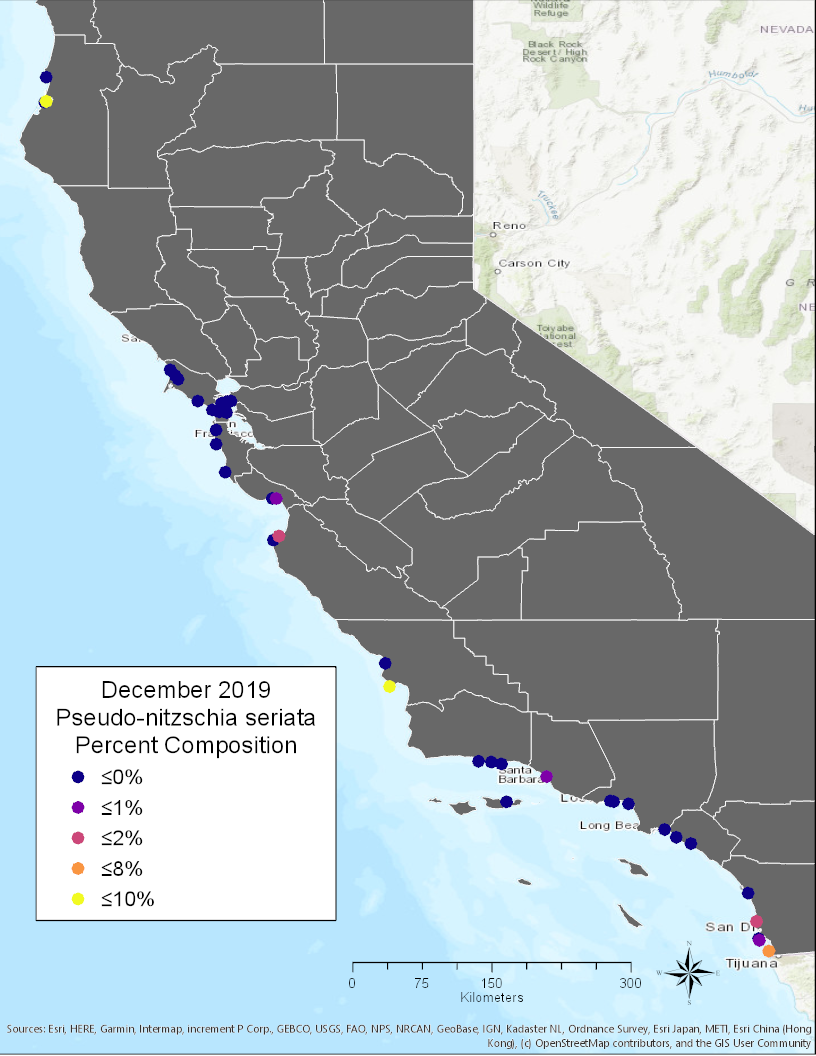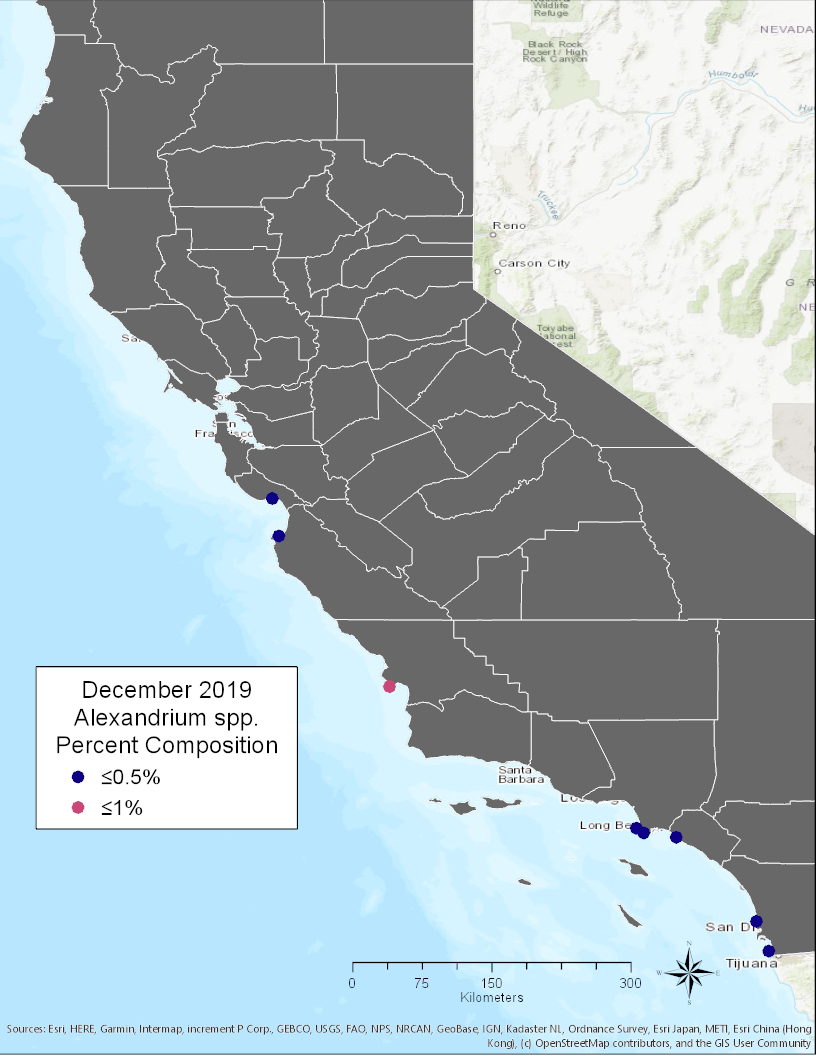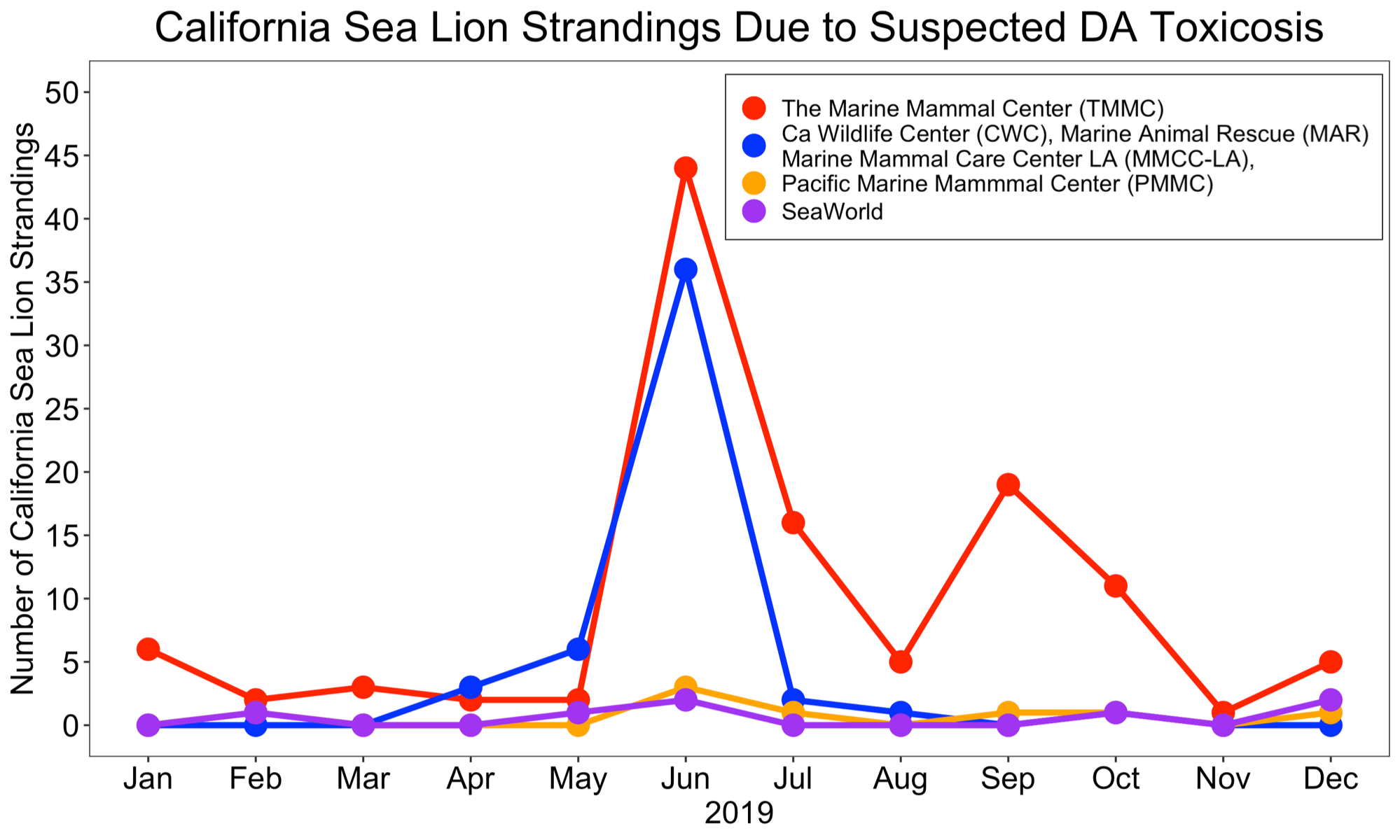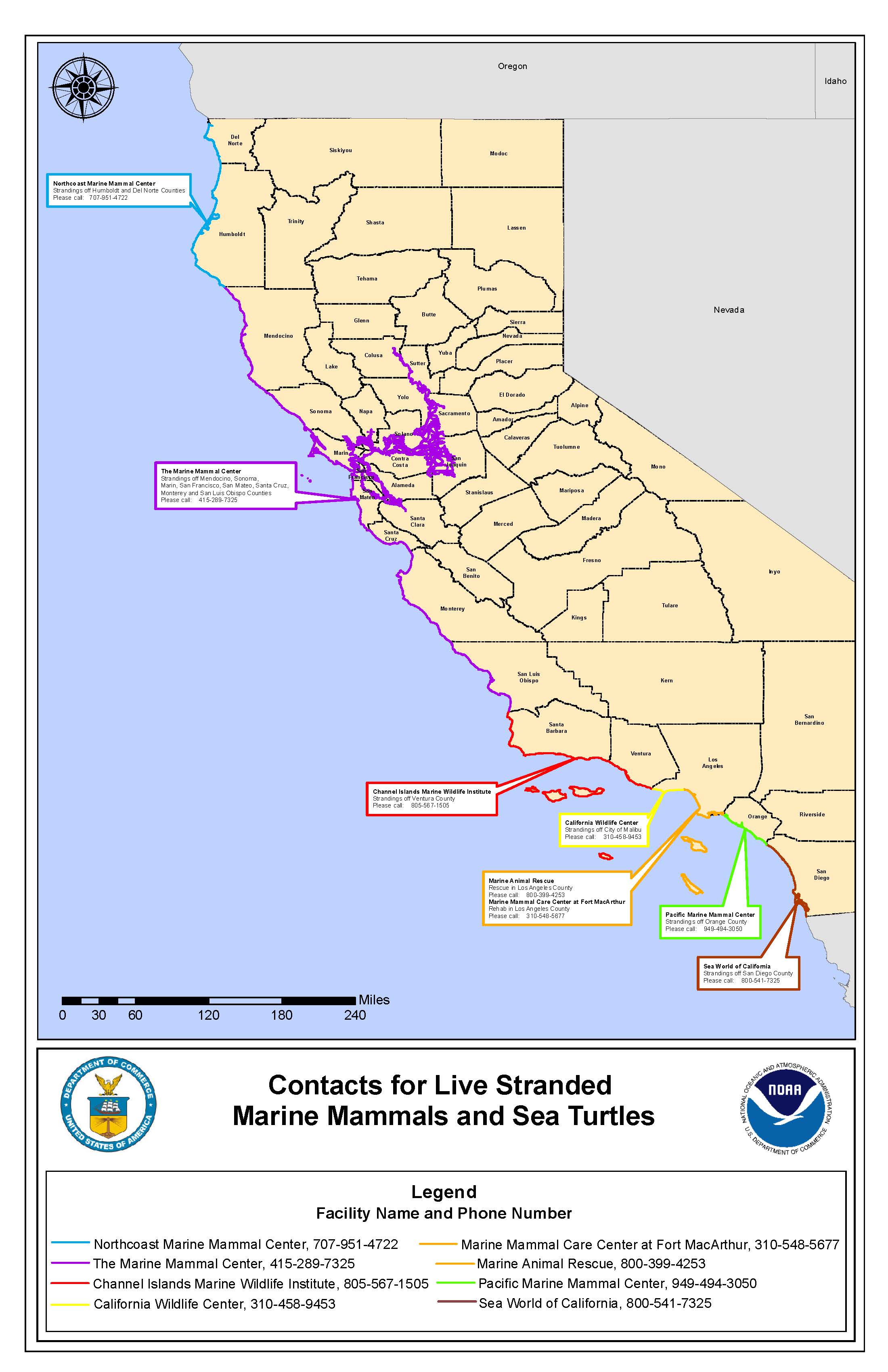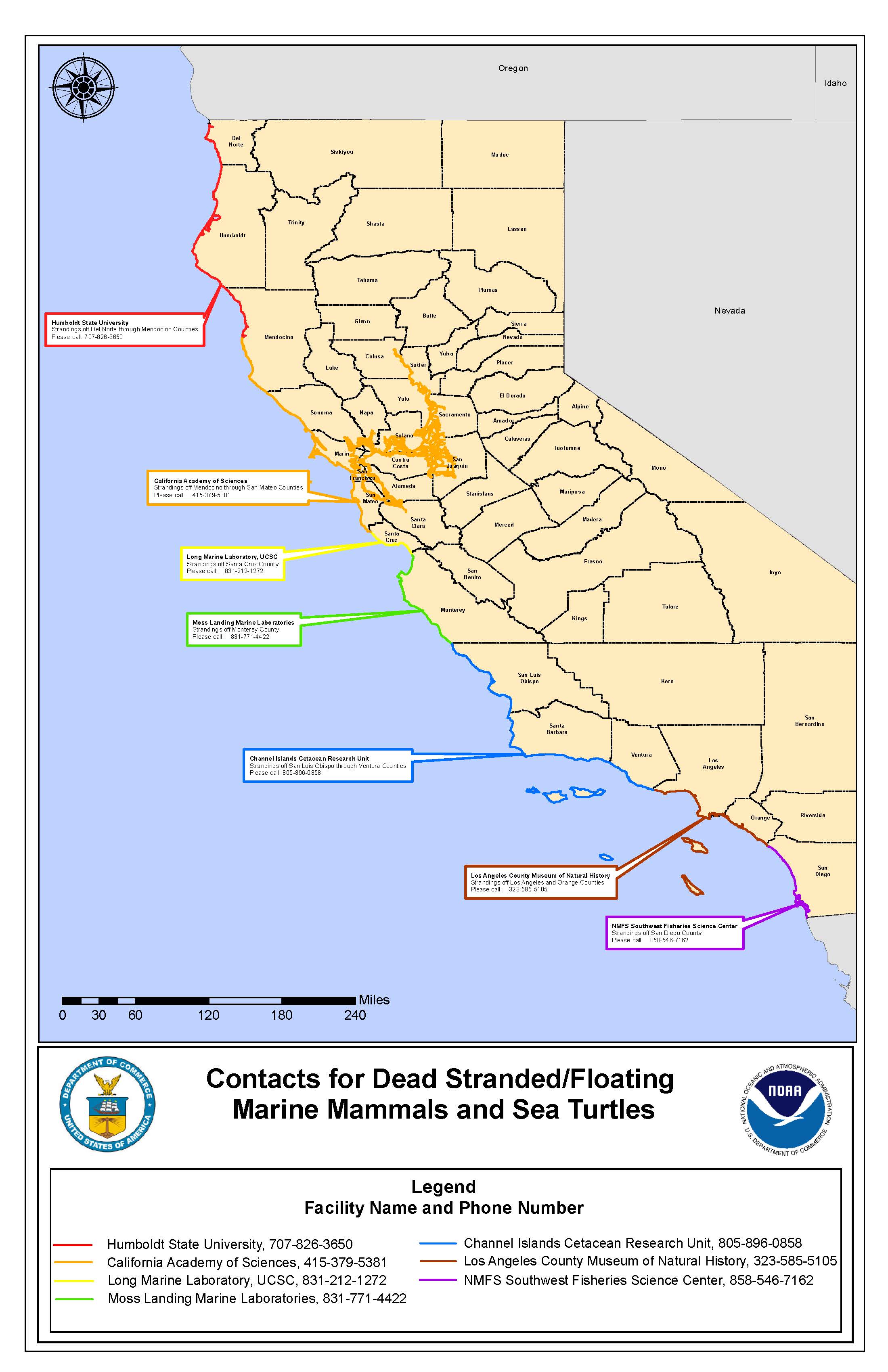Pseudo-nitzschia - C-HARM tells us where conditions are suitable for species of the diatom Pseudo-nitzschia spp. (all size classes) to grow well and where they might be more likely to produce domoic acid (DA). In contrast to previous months, predicted suitable habitat for Pseudo-nitzschia spp. was fairly patchy throughout coastal California in December. The San Diego and Orange County areas had notable high probabilities for Pseudo-nitzschia blooms at various times, with the San Diego patch appearing to move north over the course of the month. The probability of a Pseudo-nitzschia bloom was suppressed around the Los Angeles county area, while the Monterey Bay was mostly predicted to be a hot spot for Pseudo-nitzschia spp. in December, peppered with periods of lower probabilities. C-HARM predicted high but patchy probabilities of high particulate DA (pDA) throughout most of the state in December. Northern Californian regions, such as Humboldt and Mendocino Counties, displayed high probabilities of pDA early in the month, followed by variable patches of high pDA risk that moved closer to the coast by the end of the month. Further south in Sonoma and Marin Counties, pDA risk was mostly low but higher nearshore in northern regions of that domain towards the end of the month. Relative to previous months in the fall, central CA appeared to have a higher risk of high pDA in December, with offshore, patchy high probabilities, and very high probabilities around San Luis Obispo County and Pt. Conception in mid-December and again at the end of the month. Probabilities for pDA events were high in the Southern California Bight until the end of December but then dissipated into distinct maxima around San Diego and Orange Counties, consistent with the Pseudo-nitzschia bloom predictions. Cellular DA (cDA) probabilities were also high in central CA and increased over the course of the month, merging with peaks in cDA probabilities in the Santa Barbara Channel at the end of December. To the north in Monterey Bay, cDA probabilities bounced around 0-50% throughout December but were high outside the San Francisco Bay, in parts of Sonoma County and Northern California in early December. Those high predictions peaked in mid-month for Northern California. In Southern California, San Diego and Orange Counties displayed distinct boluses of high cDA probability that peaked at the end of the month, again consistent with the pDA and Pseudo-nitzschia predictions.
In comparison with the Harmful Algal Bloom Monitoring and Alert Program (HABMAP) measurements where we have December data currently available, Scripps Pier (San Diego County) and Newport Beach Pier (Orange County) both witnessed blooms levels of Pseudo-nitzschia in December, consistent with C-HARM predictions. The difference was that P. "delicatissima" (the less toxigenic group) bloomed at Scripps Pier, with only slightly elevated abundances of P. "seriata" (the more toxigenic group), while in contrast, both bloomed at Newport Beach Pier. No data are yet available at any of the HABMAP sites to compare with pDA or cDA predictions from C-HARM. There was a small pulse of Pseudo-nitzschia "delicatissima" size class at Santa Monica Pier at the end of December. Both size classes were elevated at Stearns Wharf in December but only P. "delicatissima" size class reached what might be considered bloom levels, while at Cal Poly Pier, the P. delicatissima size class was also elevated but did not reach bloom levels. At Santa Cruz Wharf, Pseudo-nitzschia spp. abundance was low or zero for the two weeks sampled in December.
CDPH recorded their highest relative abundances of Pseudo-nitzschia seriata size class near San Luis Obispo along the central coast and near Humboldt/Eureka in Northern California. Moderately elevated abundances were found in southern San Diego County and southern Monterey Bay, all consistent with C-HARM predictions and generally in line with HABMAP sampling, with the exception of Cal Poly Pier. Note we did not yet have abundance levels available from Monterey Wharf HABMAP sampling.
Notably, there were four sea lion strandings from suspected DA toxicosis in the San Diego and Orange County areas, consistent with C-HARM predictions for DA. San Luis Obispo, Monterey, and San Mateo Counties all saw 1-2 suspected DA toxicosis cases in December, consistent with C-HARM predictions of offshore pDA and cDA in those regions.
Alexandrium - There was virtually no activity related to Alexandrium spp. or paralytic shellfish (PSP) toxins seen in HABMAP or CDPH records in the month of December, with the exception of high or elevated abundances at Stearns Wharf (600 cells/L) in the Santa Barbara Channel, where CDPH did not appear to sample in December.
Note that data for some stations are not shown because they are not yet recorded in the public HABMAP archive.
Differentiating Pseudo-nitzschia species by light microscopy is difficult. For this reason, Pseudo-nitzschia "seriata" does not refer to an actual species but rather the larger size class of Pseudo-nitzschia, which is generally a more toxigenic group of species. Alternatively, Pseudo-nitzschia "delicatissima" refers to the smaller size class that is generally non-toxigenic. The dashed line on the plots demarcates the 10,000 cells/L "bloom" threshold designated here for Pseudo-nitzschia populations only.
More information and data visualizations on the statewide HAB network and forecasting system can be found here and on the SCCOOS HABMAP page.
Santa Cruz Wharf
Water samples were collected at Santa Cruz Wharf two times in the month of December. Pseudo-nitzschia seriata group and Alexandrium spp. were not detected in either of the water samples. Domoic acid results are not yet available for the month of December. Santa Cruz Wharf does not count for Pseudo-nitzschia delicatissima group.
Monterey Wharf
Data from Monterey Wharf water samples are not yet available for the month of December.
Cal Poly Pier
Water samples at Cal Poly Pier were collected five times in the month of December. Pseudo-nitzschia delicatissima group was detected below bloom levels on December 1st, 15th, 22nd, and 29th. Alexandrium spp. were not detected in any of the samples. Domoic Acid results are not yet available for the month of December.
Stearns Wharf
Water samples were collected at Stearns Wharf three times in the month of December. Pseudo-nitzschia seriata group, Pseudo-nitzschia delicatissima group and Alexandrium spp. were detected in all three samples below bloom levels. Domoic acid results are not yet available for the month of December.
Santa Monica Pier
Water samples were collected at Santa Monica Pier five times in the month of December. Pseudo-nitzschia delicatissima group was detected below bloom levels on December 23rd and Pseudo-nitzschia seriata and Alexandrium spp. were not detected in any of the samples. Domoic acid results are not yet available for the month of December.
Newport Beach Pier
Water samples were collected at Newport Beach Pier three times in the month of December. Pseudo-nitzschia delicatissima group was detected in all three samples and was detected above bloom levels on December 3rd. Pseudo-nitzschia seriata group was detected below bloom levels on December 15th and Alexandrium spp. were detected below bloom levels on December 10th. Domoic acid results are not yet available for the month of December.
Scripps Pier
Water samples were collected five times at Scripps Pier in the month of December. Pseudo-nitzschia delicatissima group was detected in all the water samples and was detected above bloom levels on December 2nd and 16th. Pseudo-nitzschia seriata group was detected below bloom levels in four of the five water samples. Alexandrium spp. were not detected in any of the water samples and domoic acid results are not yet available for the month of December.
CDPH observations for Pseudo-nitzschia spp. and Alexandrium spp.
Please note CDPH recently moved to only reporting Pseudo-nitzschia of the seriata complex and not all Pseudo-nitzschia spp. as previously provided.
From 1-31 December 2019, water samples were collected by volunteers and sent to the California Department of Public Health (CDPH) for analysis. Pseudo-nitzschia seriata group were detected in 33 of the 84 samples. Pseudo-nitzschia seriata was detected at common density level (10% composition) on December 31st at Port San Luis.
Alexandrium spp. were detected in 11 of 11 samples in the month of December at very low density levels (<1% composition). You can also view CDPH weekly map layers of Pseudo-nitzschia and Alexandrium spp. here.
Data are provided by the California Department of Public Health, Environmental Management Branch.
CDPH and OEHHA Health Advisories
California Department of Fish and Wildlife (CDFW) Director Charlton H. Bonham issued a declaration delaying the Nov. 22, 2019 start date for the California Dungeness crab fishery south of the Sonoma/Mendocino county line until December 15, 2019 due to significant risk of marine life entanglement from fishing gear.
On December 10th, California Department of Public Health (CDPH) lifted the November 1st, health advisory to not eat the viscere of Dungeness crab caught in parts of Humboldt County (from Shelter Cove to Point Arena). On December 20th, CDPH also lifted the October 15th shellfish safety notification for Mendocino County.
For the latest closures and updates, please visit the CDFW Health Advisories page as a central location of information related to CDPH and/or OEHHA health advisories.
On July 30, 2019 the Office of Environmental Health Hazard Assessment (OEHHA) hosted the Domoic Acid Webinar: Research on Effects of Repeat Low-Level Exposures and Its Implications for Human Toxicity. The recorded webinar can be found here.
Domoic acid (DA) is a potent neurotoxin produced by some diatom species of the genus Pseudo-nitzschia. Species exposed to DA can result in seizures, epilepsy, cardiomyopathy, and death depending upon the ingested dose. DA toxicosis commonly occurs in California Sea Lions (Zalophus californianus), presumably due to a combination of foraging behavior and seasonal movements. The Marine Mammal Center (TMMC), the California Wildlife Center (CWC), the Marine Mammal Care Center Los Angeles (MMCC-LA), Marine Animal Rescue (MAR), the Pacific Marine Mammal Center (PMMC), and SeaWorld act like an emergency room by working to rescue and rehabilitate sick and injured marine mammals, seabirds, and sea turtles.
Among the six rehabilitation centers we have data for a total of eight marine mammal strandings that presented with symptoms of domoic acid toxicosis in the month of December.
California Wildlife Center and the Marine Animal Rescue did not record any stradnings due to suspected domoic acid in December.
December strandings due to suspected DA toxicosis occurred in the following counties:
- Solano (TMMC)
- December 11th, adult, male, California Sea Lion
- San Mateo (TMMC)
- December 1st, yearling, female, California Sea Lion
- Monterey (TMMC)
- December 14th, adult, female, California Sea Lion
- December 20th, yearling, male, California Sea Lion
- San Luis Obispo (TMMC)
- December 29th, juvenile, male, California Sea Lion
- Orange (PMMC)
- December 10th, adult, male, California Sea Lion
- San Diego (SeaWorld)
- December 1st, adult, female, California Sea Lion
- December 12th, adult, female, California Sea Lion
At this time we do not have data from the North Coast Marine Mammal Center or the Channel Islands Marine Wildlife Institute.
Please subscribe to CA HAB Bulletin listserv to receive the monthly CA HAB Bulletin.

